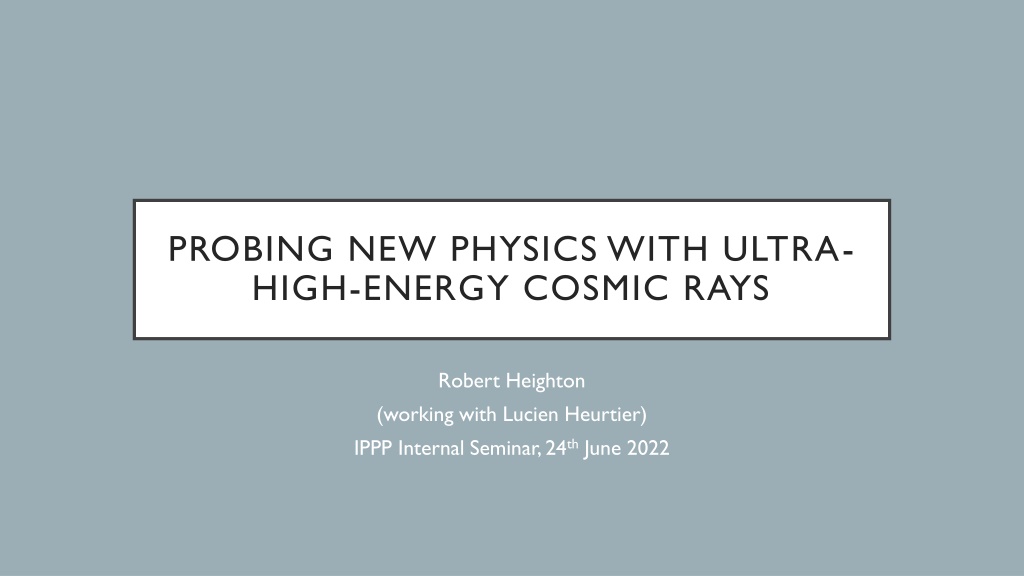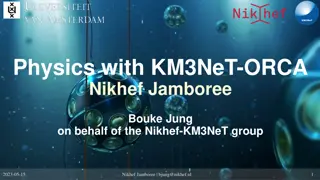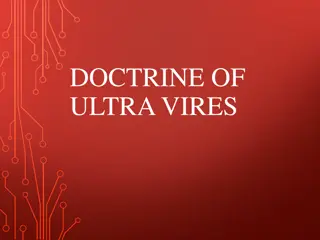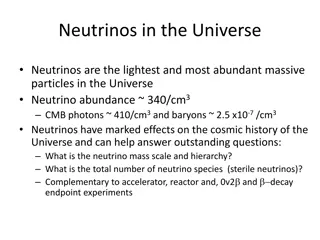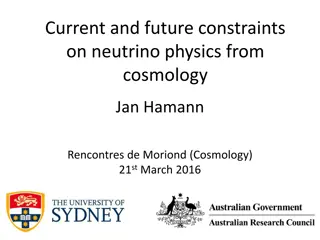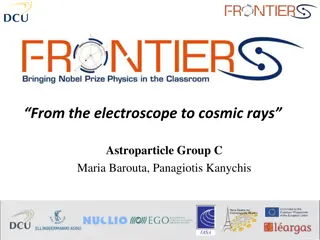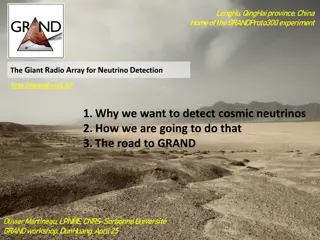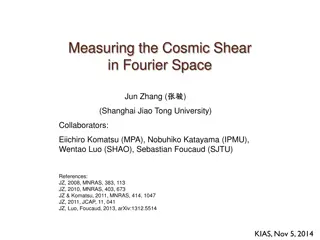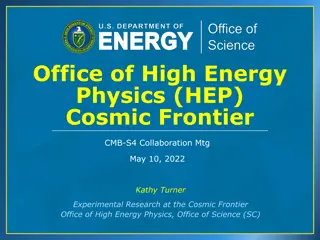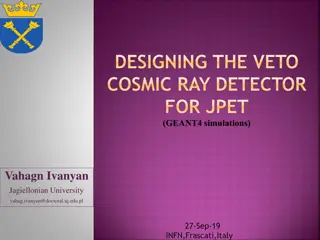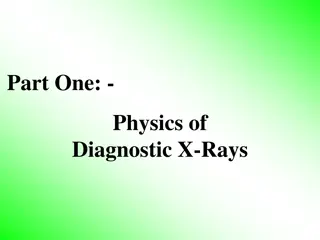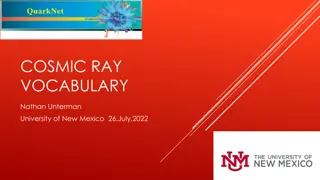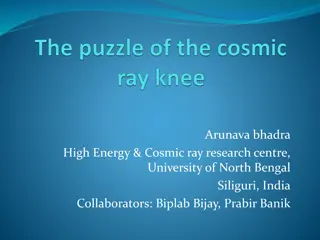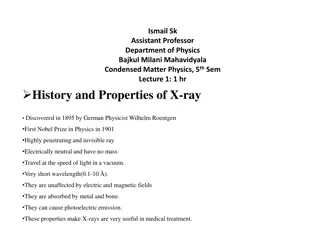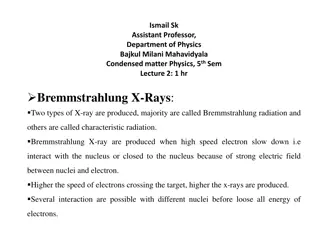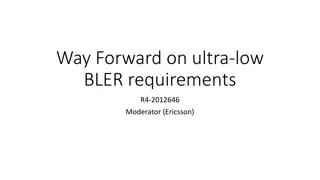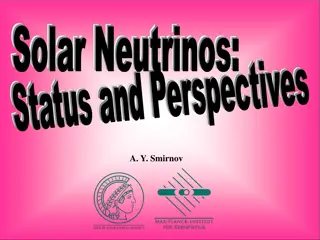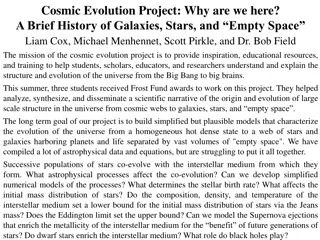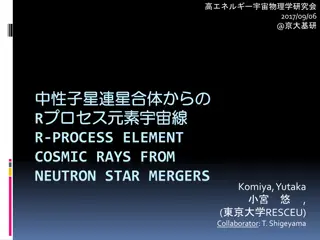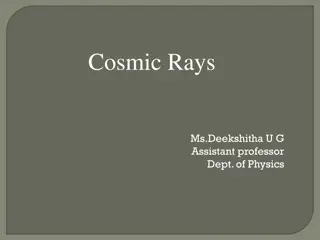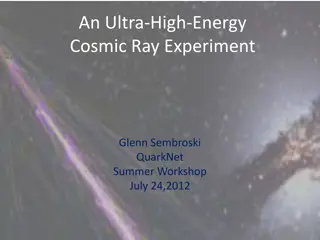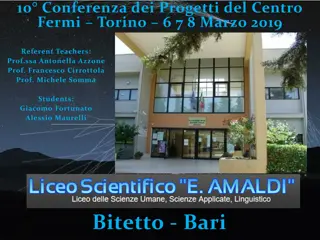Unraveling the Mysteries of Ultra-High-Energy Cosmic Rays and Neutrinos
Delve into the exploration of ultra-high-energy cosmic rays and cosmogenic neutrinos in the quest to uncover new physics phenomena. Examining the GZK limit, cosmic accelerators, detection methods, and the potential for detecting tau neutrinos in Earth, this seminar presents a comprehensive overview of cutting-edge research in the field. Investigate the implications of adding a right-handed Majorana neutrino, simulating detector results, and probing new physics at future tau neutrino telescopes. Explore the interplay between particles and energies at cosmic scales, shedding light on the fundamental forces shaping our universe.
Download Presentation

Please find below an Image/Link to download the presentation.
The content on the website is provided AS IS for your information and personal use only. It may not be sold, licensed, or shared on other websites without obtaining consent from the author. Download presentation by click this link. If you encounter any issues during the download, it is possible that the publisher has removed the file from their server.
E N D
Presentation Transcript
PROBING NEW PHYSICS WITH ULTRA- HIGH-ENERGY COSMIC RAYS Robert Heighton (working with Lucien Heurtier) IPPP Internal Seminar, 24thJune 2022
OVERVIEW UHECR and cosmogenic neutrinos Adding a right-handed Majorana neutrino Simulating detector results Conclusions 2
UHE COSMIC RAYS Cosmic rays: e.g. protons, nuclei UHE = ultra-high energy (> PeV) LHC max UHECR GeV TeV PeV EeV 109 1012 1015 1018 E [eV] 3
THE GZK LIMIT EGZK 50 EeV Protons interact with CMB p + + n + + Nuclei undergo photodisintegration Cutoff of UHECR flux 4
THE GZK LIMIT p + + n + + Pions decay Cosmogenic Neutrinos Evoli, Carmelo (2018) The Cosmic-Ray Energy Spectrum. Zenodo https://doi.org/10.5281/zenodo.4309926 5
THE COSMIC ACCELERATOR Cosmogenic neutrino flux at ~EeV scales Neutrino-proton interactions with CoM energy ~45 TeV A probe of higher energies 6
DETECTION IceCube, ANITA, Auger in future: GRAND, POEMMA, Trinity Huang et al., Probing New Physics at Future Tau Neutrino Telescopes (2021) 7
NEW PHYSICS? Huang et al., Probing New Physics at Future Tau Neutrino Telescopes (2021) 8
NEW PHYSICS? Flux SM long-lived particle Emergence angle 9
TAU NEUTRINOS IN THE EARTH NC and CC interactions Tau decay Tau regeneration Alvarez-Mu iz et al., A Comprehensive Approach to Tau-Lepton Production by High-Energy Tau Neutrinos Propagating Through Earth (2018) decay CC 10
Alvarez-Muiz et al., A Comprehensive Approach to Tau-Lepton Production by High-Energy Tau Neutrinos Propagating Through Earth (2018) 11
TAURUNNER Monte-Carlo approach to propagation of neutrinos and charged leptons Accounts for energy loss of tau Simulates neutrinos traversing chord of the Earth s interior (all within SM) 12
ADDING THE RHN Neutrinos in the standard model have left-handed chirality Possible BSM physics: right-handed neutrino Majorana neutrino coupled via seesaw mechanism 13
RHN INTERACTIONS CC and NC (with mixing) ? ? sin ?mix??+ ??????? + sin ?mix?? ???????? + h.c. 2cos?? 2 N N N W+ Z0 Z0 14
RHN DECAY Various decay modes (lighter charged leptons, neutrinos, hadrons) RHN Strongly mass-dependent decay Regeneration NCm Additional detectable air showers (analogous to taus) decay 15
RESULTS Using mass 5 GeV Varying mixing angle Incoming energy 10 EeV Define P(exit) as number of RHNs exiting with energy > 30 PeV per incoming neutrino Compare to analytical result for one interaction (dotted line) 16
DETECTOR SIMULATIONS POEMMA (satellite) GRAND array Earth 19
PRELIMINARY DETECTOR PREDICTIONS Simplified simulation of POEMMA (similar code for GRAND in progress) Modelling with optimistic cosmogenic neutrino flux within IceCube and Auger constraints Event number (of RHNs and taus) over 5-year run 20
VARYING INITIAL ENERGY Used 10 EeV Expected cosmogenic neutrino flux spread over EeV scales Simulate with lower energy 22
DISCUSSION Necessity for high energies motivates methodology Observable effects Can be used to constrain parameters 24
FURTHER STUDY Improve statistics Test other masses Predict constraints Play with further BSM models (e.g. Majoron?) 25
Dasgupta and Kopp, Sterile neutrinos (2021) 26
CONCLUSIONS BSM physics, such as a right-handed Majorana neutrino model, would affect the phenomenology of Earth-traversing UHE neutrinos, modifying results at observatories such as POEMMA. Future experimental results may allow us to constrain model parameters. The necessity of vast energies, even for exploring physics at smaller scales, motivates UHECRs as an avenue for testing BSM physics. 27
QUESTIONS? 28
